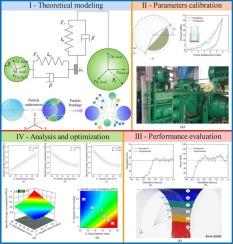基于DEM-PRM的高压磨辊辊柱参数优化研究
IF 5
2区 工程技术
Q1 ENGINEERING, CHEMICAL
引用次数: 0
摘要
本文主要研究了高压磨辊表面螺柱的尺寸和排列方式对辊体性能的影响。首先,介绍了高压辊堆的结构原理,在接触模型和粒子置换模型的基础上,建立了模拟高压辊堆运行的离散元法(DEM)仿真模型;然后,通过翻滚试验和活塞-模具试验对DEM模拟中的接触参数和断裂参数进行标定和验证。结合实验验证了高通量流场的DEM模型。建立了基于Box-Behnken设计(BBD)的螺柱参数优化仿真方案。通过方差分析(ANOVA)和响应面法(RSM)分析了螺柱直径、表面间距和角间距对HPGR性能的影响。在此基础上,建立了基于多元非线性回归的性能预测模型。以吞吐量、比能耗和排料细度为优化目标。优化后的结果表明,在降低比能耗的同时,不同程度地提高了处理量和出料细度。本文章由计算机程序翻译,如有差异,请以英文原文为准。

Optimization and study of roll stud parameters of high-pressure grinding rolls based on DEM-PRM
This paper mainly investigates the influence of the size and arrangement of studs on the surface of high-pressure grinding rolls (HPGR) on performance. Firstly, the structural principles of HPGR are introduced, and the discrete element method (DEM) simulation model simulating the operation of HPGR is established based on the contact model and particle replacement model (PRM). Then, calibration and verification of contact parameters and breakage parameters in the DEM simulation are conducted through the tumbling test and piston-and-die test. The DEM model of HPGR is validated in combination with experiments. A simulation scheme for optimizing stud parameters is established based on the Box-Behnken design (BBD). The effects of stud diameter, surface spacing, and angular interval on HPGR performance are analyzed through analysis of variance (ANOVA) and response surface methodology (RSM). Based on this, a performance prediction model based on multivariate nonlinear regression is established. Additionally, throughput, specific energy consumption and discharge fineness are taken as the optimization objectives. The results after optimization show that the specific energy consumption is reduced while throughput and discharge fineness are improved to varying degrees.
求助全文
通过发布文献求助,成功后即可免费获取论文全文。
去求助
来源期刊

Minerals Engineering
工程技术-工程:化工
CiteScore
8.70
自引率
18.80%
发文量
519
审稿时长
81 days
期刊介绍:
The purpose of the journal is to provide for the rapid publication of topical papers featuring the latest developments in the allied fields of mineral processing and extractive metallurgy. Its wide ranging coverage of research and practical (operating) topics includes physical separation methods, such as comminution, flotation concentration and dewatering, chemical methods such as bio-, hydro-, and electro-metallurgy, analytical techniques, process control, simulation and instrumentation, and mineralogical aspects of processing. Environmental issues, particularly those pertaining to sustainable development, will also be strongly covered.
 求助内容:
求助内容: 应助结果提醒方式:
应助结果提醒方式:


